#emily anthes
Explore tagged Tumblr posts
Text
Fall 2024 Behind-the-Scenes Reading
My Fall behind the scenes reading this year is very much a look a my main research project for this semester, which was on Inuit voices in the Arctic.
You’ll have to forgive this not having a picture. I am in California visiting family and therefore away from all the books I read and the end of my semester was such a mess that I didn’t have the opportunity to do a book photoshoot then. To be fair, a lot of these readings are academic articles, which might make for a boring header image. Once I’m home from California, I’ll see about getting a…
#allison hitt#anna nerkagi#bathsheba demuth#coll thrush#edward alexander#emily anthes#from ancient soil sample clues to an ice sheet&039;s future#gontran de poncins#hajo eicken#hilke thode-arora#igor krupnik#illuminations#indigenous london#jenniger spence#kabloona#karina lukin#learning about sea ice from kifikmiut#leaving novaia zemlia#making space for non-normative expressions of rhetoricity#matthew druckenmiller#northern voice#penny petrone#people of the long spring#peter elbow#rolf rodven#sara harriger#the believing game - methodological believing#the floating coast#the hagenbeck ethnic shows#the horde
0 notes
Text
#climate change#amphibious housing#elizabeth english#architecture#future#emily anthes#currently reading#currently thinking about#new yorker
1 note
·
View note
Text
C.D.C. Posts, Then Deletes, Data on Bird Flu Spread Between Cats and People
From The New York Times: Feb 6, 2025 by Apoorva Mandavilli and Emily Anthes
Cats that became infected with bird flu might have spread the virus to humans in the same household and vice versa, according to data that briefly appeared online in a report from the Centers for Disease Control and Prevention but then abruptly vanished. The data appear to have been mistakenly posted but includes crucial information about the risks of bird flu to people and pets.
In one household, an infected cat might have spread the virus to another cat and to a human adolescent, according to a copy of the data table obtained by The New York Times. The cat died four days after symptoms began. In a second household, an infected dairy farmworker appears to have been the first to show symptoms, and a cat then became ill two days later and died on the third day.
The table was the lone mention of bird flu in a scientific report published on Wednesday that was otherwise devoted to air quality and the Los Angeles County wildfires. The table was not present in an embargoed copy of the paper shared with news media on Tuesday, and is not included in the versions currently available online. The table appeared briefly at around 1 p.m., when the paper was first posted, but it is unclear how or why the error might have occurred.
The virus, called H5N1, is primarily adapted to birds, but it has been circulating in dairy cattle since early last year. H5N1 has also infected at least 67 Americans but does not yet have the ability to spread readily among people. Only one American, in Louisiana, has died of an H5N1 infection so far.
The report was part of the C.D.C.’s prestigious Morbidity and Mortality Weekly Report, which, until two weeks ago, had regularly published every week since the first installment decades ago. But a communications ban on the agency had held the reports back, until the wildfire report was published on Wednesday.
Experts said that the finding that cats might have passed the virus to people was not entirely unexpected. But they were alarmed that the finding had not yet been released to the public.
#H5N1 bird flu#this is not good#because the virus is mutating and spreading to humans#but also because the CDC isn't informing the public immediately#it might be a good idea to keep your pets inside if possible#away from any wild birds and their droppings
18 notes
·
View notes
Text
Avian flu is wreaking havoc in poultry farms and dairy cattle -- and public health experts are worried that the virus could mutate to spread among humans.1,2
Left unchecked, avian flu could result in the next deadly human pandemic. In order to prevent a public health catastrophe and reduce the impact on humans and animals, we need to take much more aggressive action.
Take action to help keep bird flu under control before it begins to pose a bigger threat to our health.
How can we reduce the risk of avian flu making the leap to humans and fueling another pandemic?
We're urging the Department of Health and Human Services (HHS) and the U.S. Department of Agriculture (USDA) to increase testing and monitoring, develop a vaccination program, and take prudent measures to protect the health of people working directly with impacted animals.
The first case of H5N1 bird flu in humans this year was confirmed in April. By November, the total number of confirmed human cases had grown to at least 52.3
Now is our chance to get this under control before it gets any worse -- but we need our public health agencies to take the right steps to make it possible.
Add your name to urge HHS and USDA to act now to reduce the spread of bird flu to humans.
These straightforward steps could make a huge difference for our health.
First, USDA and HHS should increase surveillance for bird flu in all food-producing animals. We can better track and control this disease if we have reliable data about where it is appearing and spreading in our food system. New federal rules requiring milk to be tested for bird flu on dairy farms are a great first step, but more testing and monitoring are needed.4
The agencies should also provide protective equipment and vaccines to workers who work directly with impacted animals. This will help form a shield that could stop the virus from making the leap to humans.
Developing and implementing a vaccination program for food-producing animals will also be an important way to control the spread of H5N1 bird flu.
And of course, supporting local pasture-based farms with high standards for animal welfare will make our entire food system healthier. Animals kept in clean, healthy environments are less likely to pass disease among each other, or to farm workers.
We can stop the next deadly pandemic before it starts -- but the solution has to start right now. Add your name to our petition to HHS and USDA today.
1. Susanne Rust, "As bird flu outbreaks rise, piles of dead cattle become shocking Central Valley tableau," Los Angeles Times, October 20, 2024. 2. Kai Kupferschmidt, "Many human infections with 'cow flu' are going undetected," Science, November 7, 2024. 3. "CDC A(H5N1) Bird Flu Response Update," U.S. Centers for Disease Control and Prevention, November 18, 2024. 4. Apoorva Mandavilli and Emily Anthes, "U.S. Milk to Be Tested for Bird Flu Virus," The New York Times, December 6, 2024.
@upontheshelfreviews
@greenwingspino
@one-time-i-dreamt
@tenaflyviper
@akron-squirrel
@ifihadaworldofmyown
@justice-for-jacob-marley
@voicetalentbrendan
@thebigdeepcheatsy
@what-is-my-aesthetic
@ravenlynclemens
@writerofweird
@bogleech
@anon-lephant
4 notes
·
View notes
Text
back on my bullshit (thinking about translation theory in the context of my silly little monster cartoons <3)
(this ended up so so fucking long so i put it under a read more lmao)
specifically thinking about it in the context of like a handful of world/postcolonial lit courses we took and some anth courses
what i mean by that is like
when it comes to just literature there are already so many things that have to be taken into account for translation! let's say you're taking a poem. in its native language, that poem has a sound, a rhythm, a way of communicating that a lot of poetry in a lot of languages do. when you translate it to another language, like english, are you going to translate in a way that preserves the meaning most, or a way that attempts to approximate the meaning while preserving the synesthetic qualities of its sounds?
the homeric epics are a really fun example for comparative translation analysis imo. and i mean fun because there are so many translations of them into english, and at least one madlad decided to make a prose translation of an epic poem. only recently did the first translation of the poem by a woman get published, and that revealed that a lot of biases in the linguistic nuance were kind of getting smoothed over like a crease in clay.
(i have a copy of emily wilson's translation but am not the guy who reads classics in our system, i just write the essays lmao. but she wrote multiple times about the theory of translation she was working with and if you're at all interested in this topic, look her up.)
but even if you aren't translating a text from antiquity and are, say, working with a more contemporary example of literary translation, you still have to bridge the gap between two cultures that may be very different. just a word for word translation may not work too, because figurative language like idioms might not be understood by the language you're translating to.
the amount of cultural knowledge required to sculpt a truly effective translation that preserves the image of the original while making it comprehensible to an otherwise ignorant audience is just. so cool to me. i say this as someone who could never really do translation work myself, on account of not having that kind of complex grasp on another language than my native one, of course, but you don't have to be fluently billingual to understand what i'm talking about here, imo.
another example, and one that i actually wrote comparative analysis on, is work from charles baudelaire's les fleurs du mal ("the flowers of evil"). works of short poetry are effective case studies in what different translations can look like, because translations of baudelaire's poetry still portray the subject matter in a way that is presumably true to the original french. while something may always be lost in translation (there's a saying for a reason there), the philosophy behind one's translation can also highlight one's own reading of a text, and offer a closer insight into said text for foreign audiences (me, it's me, i'm the foreign audience reading charles baudelaire in world lit and going absolutely insane about translation theory).
for my mileage, you end up seeing a paradigm between translations that span between "strict" and "loose," if that makes any sense. a strict translation makes no changes in its translation, preserving the literature in its entirety as it is translated, to the best approximation possible where a direct translation is impossible. a loose translation meanwhile may make more artistic choices in its translation, foregoing certain details in order to better articulate the artistry in the original work.
okay, now, the reason i'm thinking about this today, right now.
in literature this is already a complex subject, but when you get into other forms of art, like animation in the case of this blogs primary topic, there become a lot more moving parts. like with literature, there's going to be the simple fact of looking into a cultural window and trying to communicate that snapshot to foreigners.
with subtitling, you can add things like translator's notes. this is a non-diegetic method of communicating information to your audience, and you can see it present in literature as well (footnotes or endnotes are a frequent addition to many translated works; hell, they're common even in non-translated works). in animated works where there are vocal tracks (like anime openings or insert songs), you can also have subtitles for those, no problem!
however, when it comes to dubbing, you automatically include more elements to juggle in your translation work. you have to take into account individual voice, background tracks, visuals, etc. etc.. the method most dubs handle translating the work often discourages non-diegetic methods of communicating information, so you're less likely to see translator's notes in dub work. sometimes this even includes changing on-screen text so that a foreign audience can read it.
the lengths to which a dubbing company is willing to censor in translation is also, obviously, a conversation worth noting (see again my losing my shit at pinnochimon packing heat). a phenomenon i'm sure we've all noticed when it comes to dubbing (as opposed to most translations of literature i've seen) is that dubs may market to a specific age range in translation. sometimes that may end up defanging a work's themes, or changing them entirely. the censorship of a dub may come out of a cultural difference or hesitance to show certain subjects to a younger audience, but regardless it is part of the theory behind some dub work.
i don't really have a conclusion to this, but it's just in my mind a lot while i'm watching some of these series for the first time subbed. by all means, i don't think dubbing is a bad thing (if anything it's complex), but having the experience of watching the sub is allowing me to do a type of comparative analysis i don't think i've ever had the chance to actively do.
i know that there are folks who have done more thorough comparative analysis work than i'll probably end up doing, of course (there are so many wonderful blogs here on tumblr alone about that meta-analysis). it's just that i'm enjoying engaging with a childhood interest in a way that i suppose i didn't know i wanted to do so badly.
#sky talks#digimon#digimon adventure 02#i am not proof reading this so if anything is phrased weirdly my apologies baksdfbjhbdfs#digimon is just out here reminding me why we're trying to go to grad school lmfao and i gotta ramble#//lays flat on my office carpet contemplating translation theory for another 3000 years//#it's really funny because i almost slipped out of front on account of a flare up trying to kick our ass#i've been laying down for four hours watching digimon now though and it's like#“oh yeah right the digimon guy gets to be in front for when we watch digimon”#and here we are
2 notes
·
View notes
Text
Antonio Velardo shares: A Chimp Sanctuary With a New Urgency to Give Shelter by Emmett Lindner
By Emmett Lindner Emily Anthes, a science reporter, visited a chimpanzee sanctuary in Louisiana to observe how it prepares the animals for extreme weather. Published: August 11, 2023 at 03:00AM from NYT Times Insider https://ift.tt/7anHrJO via IFTTT
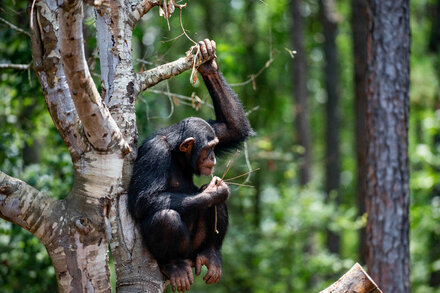
View On WordPress
3 notes
·
View notes
Link
[ad_1] Since she began working at The New York Times in 2021, Emily Anthes has written about African malaria mosquitoes, video-chatting parrots, California condor parents, the deer that got Covid-19 and even an exhibit of 500,000 leafcutter ants. Animals, she said, are one of her main beats as a science reporter. So when she visited a chimpanzee sanctuary in June, she couldn’t ignore the connections between human nature and animal instinct.“Even if we can’t know exactly what happens in their minds, they have a lot of similar experiences to humans,” Ms. Anthes said.Ms. Anthes and the photographer Emil T. Lippe traveled to Chimp Haven in Keithville, La., which is home to chimpanzees that have been retired from biomedical research, to report on how the sanctuary prepares its residents for severe and unpredictable weather. Staff members use noises from items such as cowbells or sound machines to coax the chimps from the forest into shelter. The goal is to condition the chimps so that they have a routine response to storms.Days after Ms. Anthes visited Chimp Haven, a severe thunderstorm knocked down trees and made roads around Keithville impassable. The storm added new urgency to the staff’s mission of keeping the chimps safe in a more volatile climate, and it became a driving force in Ms. Anthes’s article.In an interview, Ms. Anthes discussed her reporting trip and why it’s useful to compare animal vulnerabilities to mankind’s. This interview has been edited and condensed.How do you prepare to report a longer narrative article?I always sketch out in advance a bullet-point list of questions. I don’t keep it in front of me, but always at the end of the day, or before I’m getting ready to leave, I’ll say, Hey, can you just give me a minute? Let me just double check and make sure I didn’t miss something that I meant to ask.When I’m out reporting in the field, I’m collecting all the atmospheric stuff — how do things feel, look, smell, sound. When I’m calling someone from my desk I try to elicit that stuff from them, but in this case the onus was on me to capture all those details and to notice them in the first place.What was it like to experience the sanctuary? Was there anything that you didn’t have room or time to put in the article?The story does have this narrative component of taking people through what happened after a severe thunderstorm. But the interesting thing is that the storm happened after my visit. When I went, I didn’t know that there was this severe storm coming, that it would be in the story, that it would provide a narrative structure. I was very focused on what was happening on the day. And, interestingly enough, the weather was pretty wild even on the day I was there.Did that cause you to think about extreme weather in relation to humans, and the kind of precautions we all need to take?The sanctuary’s staff members are there to take care of these chimps, and they take that seriously. But they also have a large human staff and they live and work in the area, too. They’re also affected by these weather events. Sometimes you get very little warning. What would you do if a tornado was coming in five minutes and you were supposed to take shelter? They said, Well, staff safety comes first.In an article like this one, do you try to stay away from projecting too many human attributes onto animals?I write a lot about animals, and it’s something that’s always a tricky line. From a scientific perspective, we certainly don’t want to anthropomorphize animals. They’re not human. They’re creatures with their own ways of being in the world, processing the world and moving through the world. But sometimes anthropomorphizing gets treated as a dirty word. It’s sometimes useful to draw parallels between animal experiences and human life.It can cause the reader to relate more to the subjects you’re writing about, even if they’re not human.There is certainly plenty of reason to believe that animals, especially chimpanzees, which are so closely related to us, have a lot of similar experiences to humans. It’s not a huge stretch to, in the case of this story, imagine that a chimp might be nervous or afraid during a storm. They do have complex social bonds and hierarchies, much like humans do. Some of that is not such an enormous stretch. In some ways, it would be surprising if they didn’t have experiences that were very similar to our own. [ad_2]
2 notes
·
View notes
Text
What Ants and Orcas Can Teach Us About Death
— A philosopher journeys into the world of comparative thanatology, which explores how animals of all kinds respond to death and dying. Susana Monsó, a philosopher of animal minds at the National Distance Education University in Madrid. “I’ve always been interested in those capacities that are understood to be uniquely human,” she said. “Death was a natural topic to pick up.” By Emily Anthes In…

View On WordPress
0 notes
Text
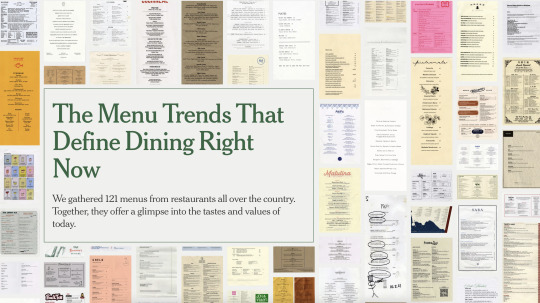
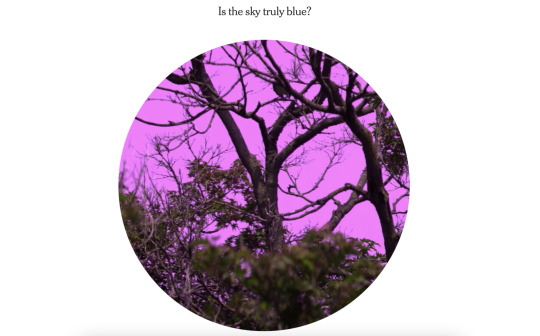

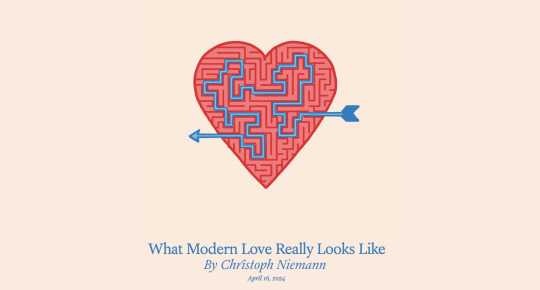
⩔ Pasamos en muchas ocasiones de puntillas por los geniales trabajos que el New York Times publica en su web cada día y debemos pararnos más a menudo para deleitarnos sobre los originales nuevos formatos que con ahínco proponen sobre diversos temas. En el post de hoy hemos recuperado cuatro trabajos de las últimas semanas:
> Arriba a la izquierda, las tendencias de diseño en los menús de EEUU, a través de un análisis sobre las secciones, ilustraciones, propuestas y diseños de 121 menús del país. Un trabajo de Priya Krishna, Tanya Sichynsky y Umi Syam.
> Arriba a la derecha, cómo ven el mundo los animales, gracias a la nueva tecnología que nos enseña en qué colores y formas perciben el entorno las aves o los insectos. Es un trabajo de Emily Anthes.
> Abajo a la izquierda, entendiendo el complejo sistema de relaciones entre los países protagonistas de la tensión en Oriente Medio, un esquema muy visual de Daniel Levy con gráficos de Gus Wezerek.
> Abajo a la derecha, cómo luce en la actualidad el amor moderno, en un ensayo ilustrado a través de más de una decena de propuestas románticas -y no tanto- de Christoph Niemann.
» Web del The New York Times, de enero a abril de 2024
1 note
·
View note
Text

Michaela Blyton, a postdoctoral researcher at the University of Queensland, and her colleagues are working on ways to help koalas digest food better while on antibiotics.
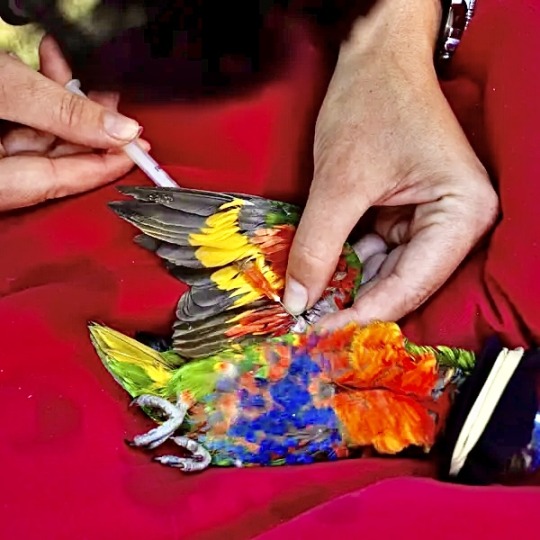
A veterinary nurse treats an injured rainbow lorikeet at Currumbin Wildlife Hospital.
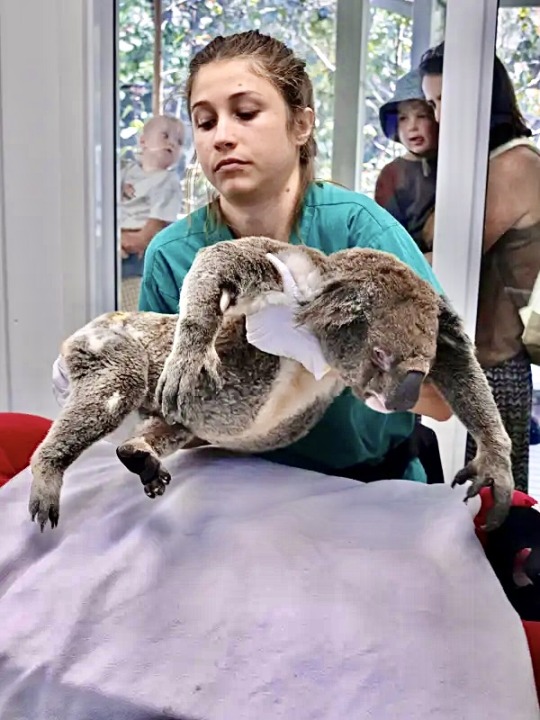
A veterinary nurse treats a koala infected with chlamydia at the Currumbin Wildlife Hospital in Currumbin, Australia.
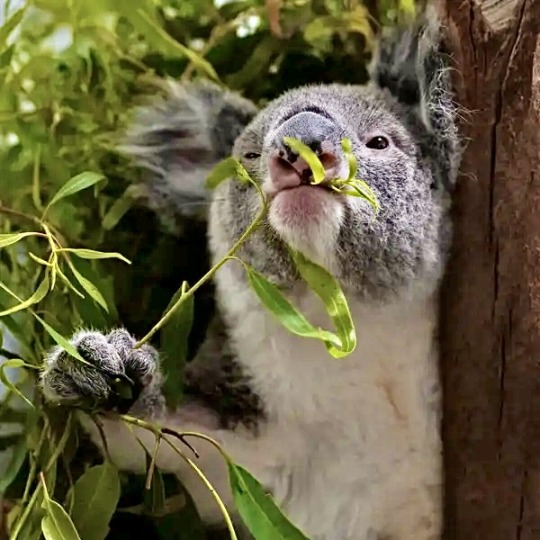
Blinky, a patient at Moggill Koala Rehabilitation Center.
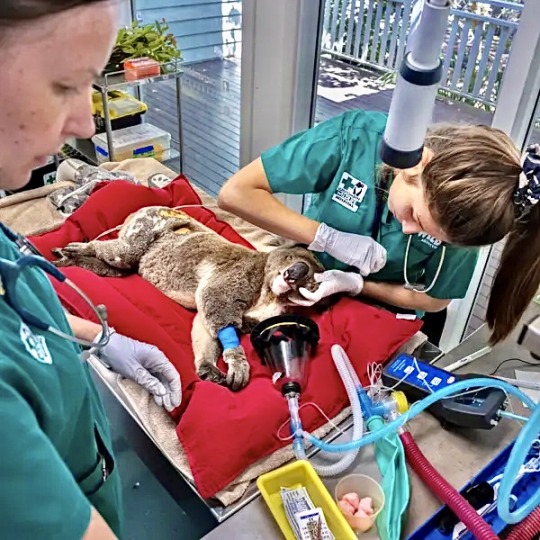
A koala being treated at the Currumbin Wildlife Hospital.

Chewing and sleeping at Currumbin Wildlife Sanctuary. Koalas — sedentary and tree-dwelling — are tricky to spot in the wild.
Four Wild Ways to Save the Koala (That Just Might Work)
To protect Australia’s iconic animals, scientists are experimenting with vaccine implants, probiotics, tree-planting drones and solar-powered tracking tags.
By Emily Anthes
Photographs and Video by Chang W. Lee
This story is part of a series on wildlife conservation in Australia, which Emily Anthes reported from Australia and New York.
The New York Times - April 16, 2024
•
•

Koala pelts from Queensland used to be sold on the international market.
(Photo: Unsplash / Photoholgic)

This truckload of koala pelts was taken during the 1927 open season in Queensland.
(Photo supplied: State Library of Queensland)

Victorian trapper Cyril Grant Lane hunted koalas for many years.
(Photo supplied: State Library of Victoria)
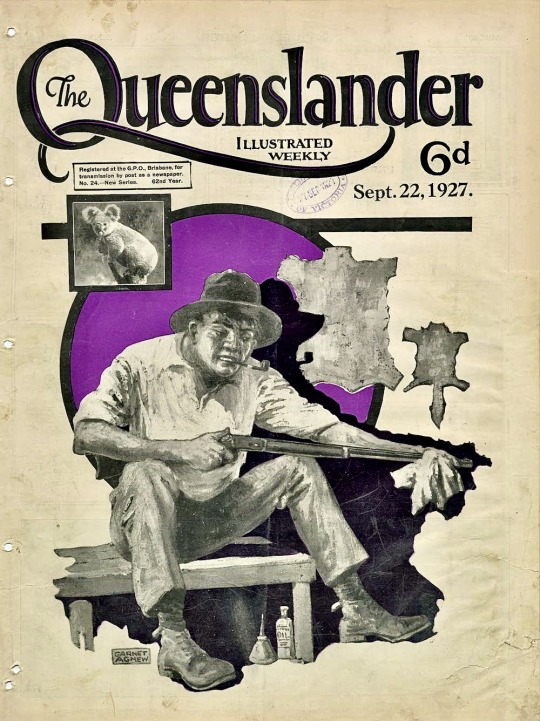
The backlash against the koala cull was fast – and intense, as seen in The Queenslander in September 1927.
(Photo supplied: State Library of Queensland)
We once killed 600,000 koalas in a year. Now they're Australia's 'teddy bears'. What changed?
Koalas are one of the world's most beloved animal species. They serve as symbols for everything from bushfire destruction to Australian tourism to caramel chocolate bars. These tree-dwelling marsupials get far more attention than many other endangered native species.
But Australians haven't always felt this way about our seemingly cuddly teddy-bear lookalikes. Far from it.
Almost a century ago, Queensland announced open season on koalas. Over the next month, well over 600,000 koalas were shot, trapped or poisoned in what has been dubbed "Black August".
By Ruby Ekkel
The Conversation & ABC News - 31 January 2024
•
0 notes
Photo
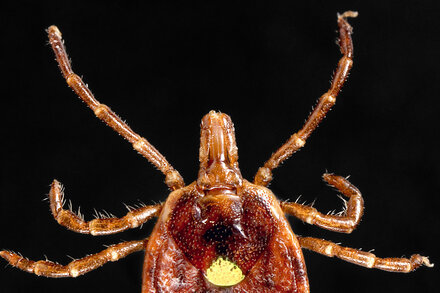
"A Half-Million Americans May Have Tick-Linked Meat Allergy, C.D.C. Says" by Emily Anthes via NYT Health https://www.nytimes.com/2023/07/27/health/alpha-gal-ticks-meat-allergy.html?partner=IFTTT
0 notes
Text
Wild Mammals Roamed When Covid Kept Humans Home
By Emily Anthes Strict pandemic lockdowns may have allowed animals to range more widely and spend time closer to roads, a new study suggests. Published: June 8, 2023 at 02:00PM via NYT Science https://ift.tt/Nyj3xv1
0 notes
Text
Full article under the cut for access:
C.D.C. Posts, Then Deletes, Data on Bird Flu Spread Between Cats and People
The data, which appeared fleetingly online on Wednesday, confirmed transmission in two households. Scientists called on the agency to release the full report.
[Image of a black-and-white cat walks along a wooden retaining wall.]
[Image caption: Scientists have long known that cats are highly susceptible to the virus, but there had not previously been any documented cases of cats passing the virus to people. Credit...Ramsay de Give for The New York Times]
By Apoorva Mandavilli and Emily Anthes Feb. 6, 2025
Cats that became infected with bird flu might have spread the virus to humans in the same household and vice versa, according to data that briefly appeared online in a report from the Centers for Disease Control and Prevention but then abruptly vanished. The data appear to have been mistakenly posted but includes crucial information about the risks of bird flu to people and pets.
In one household, an infected cat might have spread the virus to another cat and to a human adolescent, according to a copy of the data table obtained by The New York Times. The cat died four days after symptoms began. In a second household, an infected dairy farmworker appears to have been the first to show symptoms, and a cat then became ill two days later and died on the third day.
The table was the lone mention of bird flu in a scientific report published on Wednesday that was otherwise devoted to air quality and the Los Angeles County wildfires. The table was not present in an embargoed copy of the paper shared with news media on Tuesday, and is not included in the versions currently available online. The table appeared briefly at around 1 p.m., when the paper was first posted, but it is unclear how or why the error might have occurred.
The virus, called H5N1, is primarily adapted to birds, but it has been circulating in dairy cattle since early last year. H5N1 has also infected at least 67 Americans but does not yet have the ability to spread readily among people. Only one American, in Louisiana, has died of an H5N1 infection so far.
The report was part of the C.D.C.’s prestigious Morbidity and Mortality Weekly Report, which, until two weeks ago, had regularly published every week since the first installment decades ago. But a communications ban on the agency had held the reports back, until the wildfire report was published on Wednesday.
Experts said that the finding that cats might have passed the virus to people was not entirely unexpected. But they were alarmed that the finding had not yet been released to the public.
“If there is new evidence about H5N1 that is been held up for political purposes, that is just completely at odds with what government’s responsibility is, which is to protect the American people,” said Jennifer Nuzzo, director of the Pandemic Center at the Brown University School of Public Health.
It was important that the C.D.C. immediately publish the full data and the context in which they were collected for other scientists to review, she said.
Scientists have long known that cats are highly susceptible to the virus. At least 85 domestic cats have been infected since late 2022, according to the U.S. Department of Agriculture. But there had not previously been any documented cases of cats passing the virus to people.
“Given the number of cats in the U.S. and the close contact with people, there is definitely a need to understand the potential risk,” said Dr. Diego Diel, a veterinarian and virologist at Cornell University.
Although cats may be infected when they prey on infected wild birds, cases among domestic cats in the United States began rising last year as the virus spread through dairy farms. On many farms, dead cats were the first signal that cows had been infected. Several recent cases in pet cats have also been linked to contaminated raw pet food or raw milk.
H5N1 is often fatal in cats, which may develop severe neurological symptoms.
Historically, H5N1 has primarily affected birds. But over the last several years, new versions of the virus have proved capable of infecting a wide range of mammals, including wild and domestic cats, seals and dairy cows. Infections in mammals give the virus more opportunities to evolve in ways that could allow it to infect humans more easily.
Apoorva Mandavilli reports on science and global health, with a focus on infectious diseases, pandemics and the public health agencies that try to manage them. More about Apoorva Mandavilli
Emily Anthes is a science reporter, writing primarily about animal health and science. She also covered the coronavirus pandemic. More about Emily Anthes
A version of this article appears in print on Feb. 8, 2025, Section A, Page 17 of the New York edition with the headline: Data on Bird Flu Spread Is Posted, Then Deleted.
🫠🫠🫠
#full article#access#new york times#h5n1#data withholding#virus#flu#transmission#cats#and#humans#usa#data#rights
1 note
·
View note
Text
Ben and Sammy really take absolutely every opportunity to remind the listening public that they are indeed best friends and they love eachother very very much huh? They can't even address their other friends without adding 'co' in front of 'best friend'.
#ben arnold#sammy stevens#king falls am#kfam#i love them so much#emily loves them so she doesnt say anthing but i garenty they are defo the kind of friends who third wheel the gf#jack comes back and he and emily bond over being 'the SOs'#jack wright#emily potter
31 notes
·
View notes
Text
where the heart is
a domestic syllabus [x]
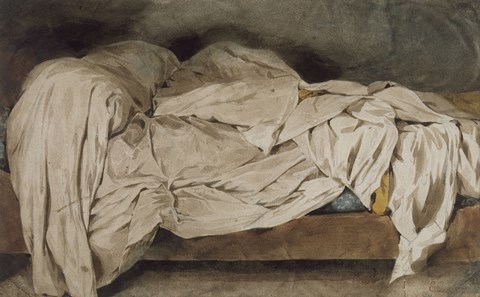
"lecture on the history of the house" by claire schwartz
poem by american poet claire schwartz, published in poetry magazine and her 2022 collection civil service.
"the house. from cellar to garret. the significance of the hut" by gaston bachelard
the opening chapter to bachelard's seminal work the poetics of space. bachelard theorizes that the house's role as a site of reverie lends it a profound influence on the psyche. coining his own term, topoanalysis, to explore this influence; he surveys different poetic images of houses as representations of mind and soul.
the bedroom: an intimate history by michelle perrot, trans. by lauren elkin
french historian michelle perrot's history of the western bedroom as the site of birth, sex, illness, and death; from the ancient greek kamára to the postmodern bedrooms of today. perrot traces developments in the bedrooms of royalty, families, laborers, women, children, recluses, monks, and travelers. see also "black in bed" by art historian ella ray on the legacy of black bed art and "the bedroom of things" by caitlin blanchfield and farzin lotfi-jam for a discussion of private space through digital images.
rooms by rohan mcdonald
animated short film by illustrator rohan mcdonald featuring interviews with participants about their rooms and homes.
never home alone: from microbes to millipedes, camel crickets, and honeybees, the natural history of where we live by rob dunn
book by biologist rob dunn about the nearly 200,000 other species that live in our homes, from welcome pets to reviled pests. dunn's work researching the ecosystems of houses has illuminated the sheer scope of creatures that thrive there, often unbeknownst to both inhabitants and scientists, as well as the benefits of a biodiverse household.
"human stains" by heather havrilesky
author and "ask polly" columnist heather havrilesky on the endlessness of housework and "the strange gift that laundry brings to our lives."
the midcentury kitchen: america's favorite room from workspace to dreamscape, 1940s-1970s by sarah archer
a visual history of american kitchens, using examples of advertising and deisgn photography to show the evolution of their aesthetics, technology, and cultural ideals. see also sarah archer's episode of you're wrong about on martha stewart.
"full spectrum" and "if these walls could talk, listen, and record" by emily anthes
excerpts from the great indoors by science journalist emily anthes, which investigates the intersections of health and design in indoor spaces. "full spectrum" (republished by next city as "everyone has a basic right to good design") follows an apartment complex designed for autistic adults. "if these walls could talk, listen, and record" (republished by slate as "senior care homes are becoming high-tech medical devices") reports on the promise and limitations of smart home technology for the elderly.
"inside out, or interior space" by rebecca solnit
essay from rebecca solnit's collection of work on place, the encyclopedia of trouble and spaciousness. solnit discusses the pursuit of the "dream home" through decoration and renovation, examining our desire to craft the perfect nest.
windowswap by sonali ranjit and vaishnav balasubramaniam
a collaborative online database of user-submitted videos shot from windows around the world. conceived as a way to "travel" during early phases of the covid-19 pandemic, visitors can shuffle through videos to experience the views from homes in a plethora of different environments.
#syllabi#this is another one that could have gone on and on!#cover image is unmade bed by eugene delacroix
688 notes
·
View notes
Text
Antonio Velardo shares: Our Rodent Selfies, Ourselves by Emily Anthes
By Emily Anthes A photographer trained two rats to take photographs of themselves. They didn’t want to stop. Published: January 23, 2024 at 12:02AM from NYT Science https://ift.tt/RsgoSQ2 via IFTTT

View On WordPress
0 notes